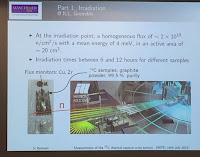It's a busy time conference-wise in the UK. The week after next sees the world's largest periodic nuclear physics conference, INPC, taking place in Glasgow. Next week I'll be at a conference organised here at Surrey on ab initio methods, designed to attract delegates attending INPC the following week. That clashes with a workshop on octupole shapes in nuclei, taking place even more conveniently for INPC attendees, in Paisley.
This week there is a workshop at the University of York to celebrate the conferring of an honorary degree on Witek Nazarewicz, which would have been nice to attend, but I am staying in Surrey this week to attend our graduation ceremony (on Friday) and the Universities Nuclear Technology Forum (UNTF2019) today to Thursday.
The topics of #UNTF2019 cover a wide range of nuclear science and engineering, so I hope to learn a lot of things that are not so close to my own area.
Here is a live-blog summary of the first session:
First up is Sam Bennett (Manchester) who has performed new measurements on the capture of neutrons on C–13 in order to help understand how the long-lived radioactive contaminant C–14 is generated in graphite-moderated reactors. The cross section for this reaction has been measured a few times historically, going back around 60 years, but there is inconsistency in the data. Sam's work uses a method different to the past measurements -- irradiating a sample of carbon and using atomic mass spectroscopy to anaylse the results. He discussed in some detail how to counter the problem of N–14 contamination in the samples. The conclusion: Good agreement with the most recent calculation which has been taken as the adopted value.
Second, Emma Braysher (Surrey/NPL), talks about the need to improve measurements of half-lives of long-lived isotopes for their use in things like radio-dating. Surprising (to me) is that Uranium-238 has only had its mass measured once before (until very recently) and that the experimental uncertainty is a million years. Emma talks about using mass spectroscopy to measure half-lives; either one can use isotope dilution in which the isotope which one wants to measure is diluted with (preferably a stable) isotope of the same element as a reference and mass spectrometry is used to measure the ratio of the isotopes; or one uses the in-growth method in which ones looks at the build-up over time of the daughter produces of the decay of the isotope in question. The work presented showed the speaker's theoretical studied so far, with the experimental realisation the next stage in her project.
The third speaker is Rhiann Canavan (Surrey/NPL) who begins by asking what can be done with the large amount of U–238 waste from our standard nuclear reactors. U–238 is not fissile, but is fertile so can be turned into a fissile material (in this case, isotopes of plutonium) by reaction with fast neutrons. The fissile material can then be used as commercial fission reactor fuel. The goal of Rhiann's work is to better understand the fast-breeding reactions which convert U–238 in to a fissile material and the resulting range of fission fragments. In Orsay, near Paris, Rhiann and co-workers used an intense neutron source, LICORNE, to breed U–238 into fissile isotopes, and then a gamma-ray detector, NuBall, to look at the decay of the hot fission fragments. A phenomenal amount of data is collected from the reactions, which then has to be painstakingly analysed, both for the fission decay products of interest, and also to avoid the background signal (e.g. from decay of germanium isotopes in the gamma-ray detector itself). It's the first time I've seen a description of gamma-ray gating in spectroscopic analysis in terms of selecting coloured jelly-babies from a pile of sweets.
The final speaker is Thomas Fried (Lancaster). As well as his affiliation to Lancaster Uni, Thomas works at Sellafield and is concerned with long-term decommissioning of the site. This includes, in particular, older waste that has been processed for storage. Some of it is known as "heat-generating sludge" and Thomas's project aims to develop a mechanism for assessing the properties (mechanical, thermodynamic) properties of the stored sludge. The slide shows a schematic of the prototype mechanism.
I don't think I'll live-blog the whole thing, but I hope this gives you a flavour of the conference. Next up: Coffee break :-D




No comments:
Post a Comment